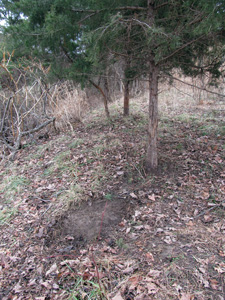
 If you hunt whitetail anywhere except the deep South and Texas, you were smart to stop hunting scrapes a few weeks ago. Once the rut phase moved from seek-and-chase to peak breeding, there was no need for bucks to visit these calling cards.
If you hunt whitetail anywhere except the deep South and Texas, you were smart to stop hunting scrapes a few weeks ago. Once the rut phase moved from seek-and-chase to peak breeding, there was no need for bucks to visit these calling cards.
There were plenty of willing females available and no need to go searching.
But after peak mating ended in November and early December, things changed. Most does were bred by then. The majority of bucks were worn out and simply wanted to hide in a thick, secluded spot and recuperate.
There's another group of bucks, though, that still want to seek out the last few does that haven't bred. These are often the oldest, biggest whitetails. No matter how tired, thin and weakened with wounds, they want to push on and find that one last doe to spread their genes through.
They'll do this by traveling between doe bedding areas, checking out feed sites late in the day, and re-freshening old scrapes and creating new ones.
Now that peak breeding is through, scrapes are once again major meeting points for late-breeding deer. And they're not just important for bucks, but does as well.
Visiting these sites is the best way for a late-cycling, un-bred doe to let bucks know they are ready and willing to mate. By checking out scrapes they distinguish themselves from the majority of does that simply want to be left alone to feed.
This makes scrapes even more productive spots than they were during the pre-rut. It lets bucks sort through the ladies quickly and find the small percentage of them that are still interested in breeding-typically fawn or yearling does.
Look for these newly-created or re-freshened scrapes on the edges of doe loafing areas and along transition corridors where they travel from bedding areas to feed fields in the evening. Also check out staging areas just off from these late feed feeding areas. Isolated clusters of brush near fallow fields and clearings in forests are other good spots to find a late active scrape.
You'll know the difference when you see them. Old ones will be dried out looking, often with leaves or sticks in them. The licking branch overhead will be graying instead of freshly bent, chewed and twisted.
Active, fresh scrapes aren't as common now as during the pre-rut, since only a limited number of bucks are still in the game. But those you find are usually made by older animals.
The smaller number also increases your chances for success. To up your odds further, search for especially large scrapes or a cluster of several close together.
Put up a deer stand or erect a simple hunting blind downwind and wait. Use a doe bleat or occasional contact grunt to entice nearby bucks hanging back in cover.
Action typically comes right at dark. If you can get in without being detected before dawn, the first hour of daylight can also be productive.
If the scrape is in a semi-open area, you may be better off trying to find a buck's approach route to it. Look for scuffled leaves and large sets of tracks in the direction of his bedding cover and backtrack 75-100 yards. He may only visit the scrape during the night, but by setting up on his approach route, you can ambush him while there's still shooting light.
If you can't find active late scrapes, make your own mock scrape. Wear rubber boots and gloves and use a hoe, rake or sharp branch to clear leaves and grass in an oval shape. Sprinkle buck or doe urine into it and take a stand downwind.
Whether real or ersatz, late scrapes offer a great setup for a blockbuster finish to the season this January.
- 5671 views

